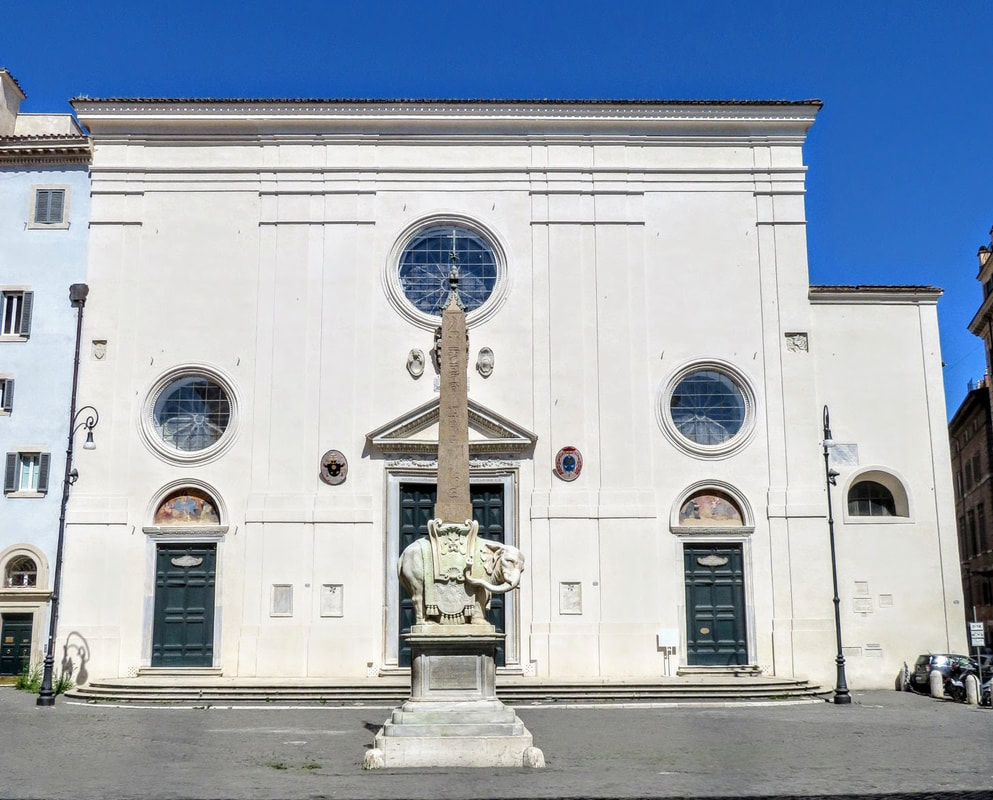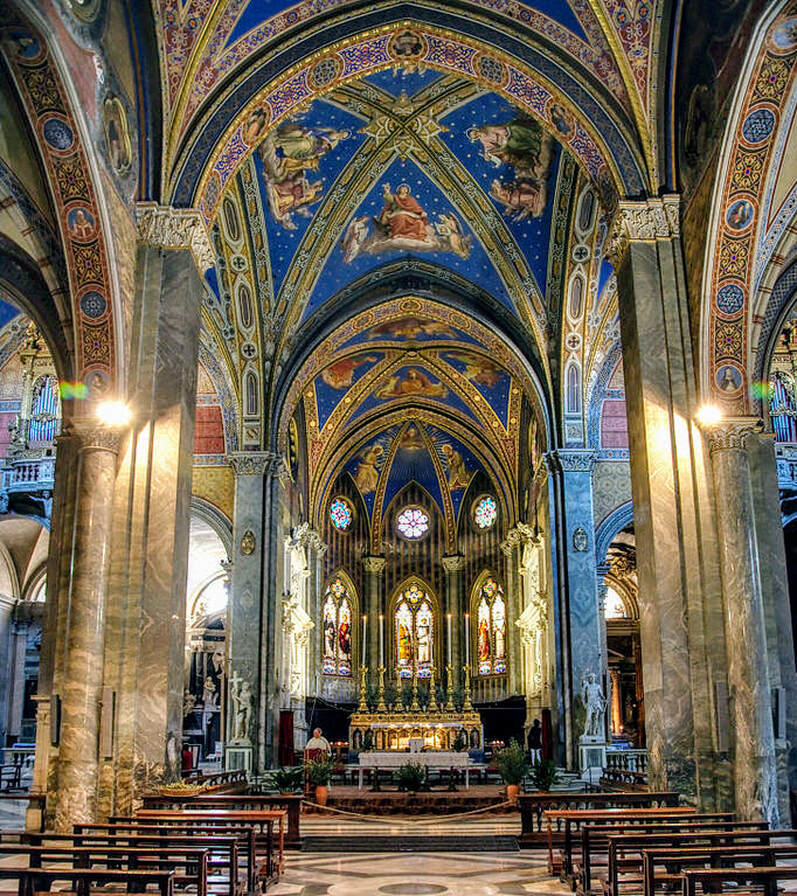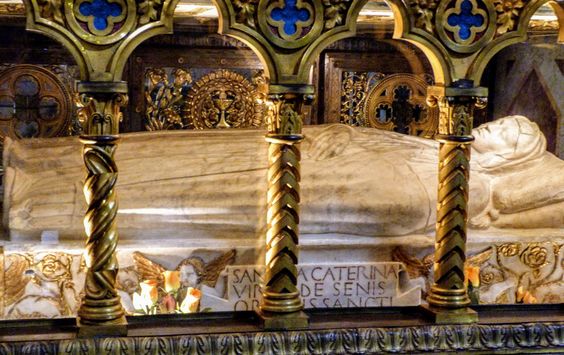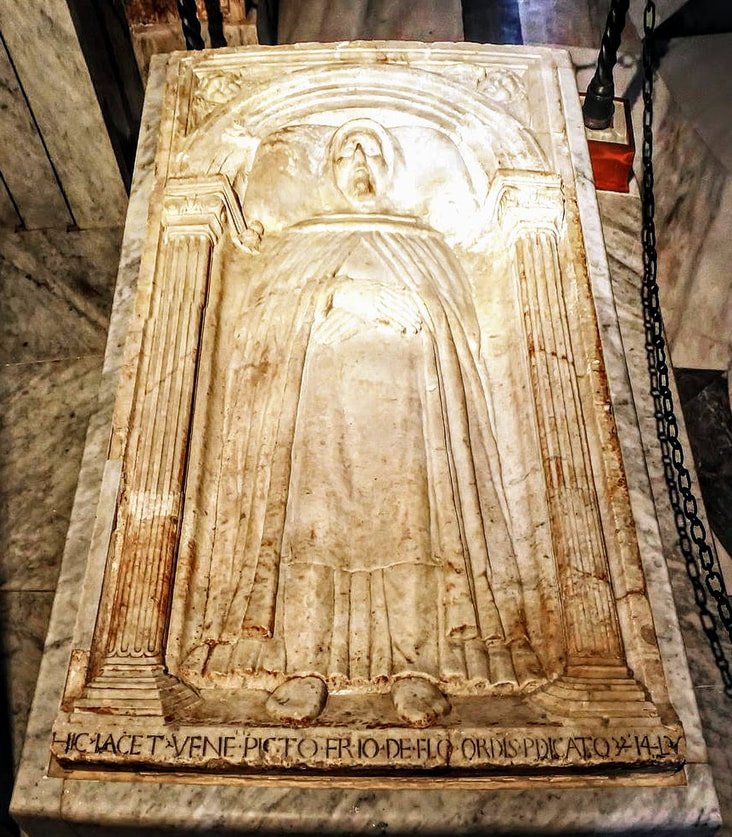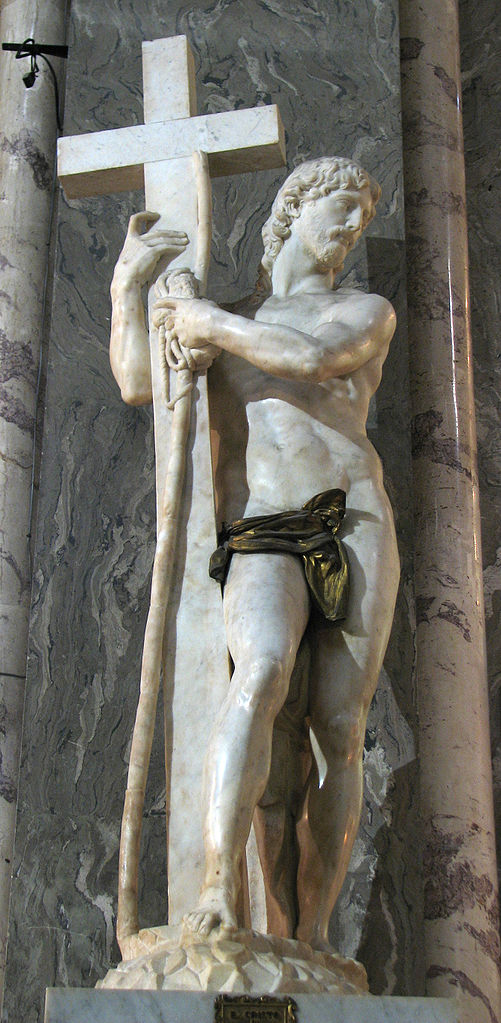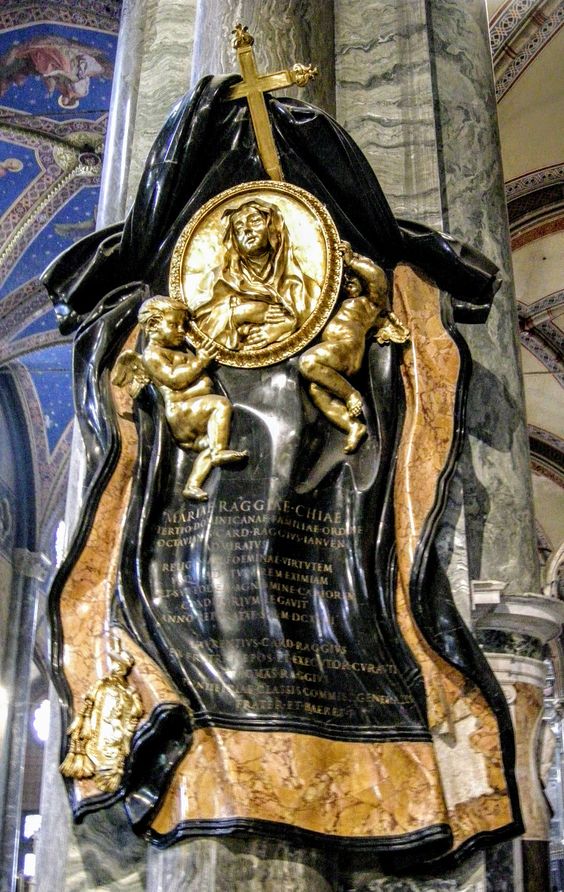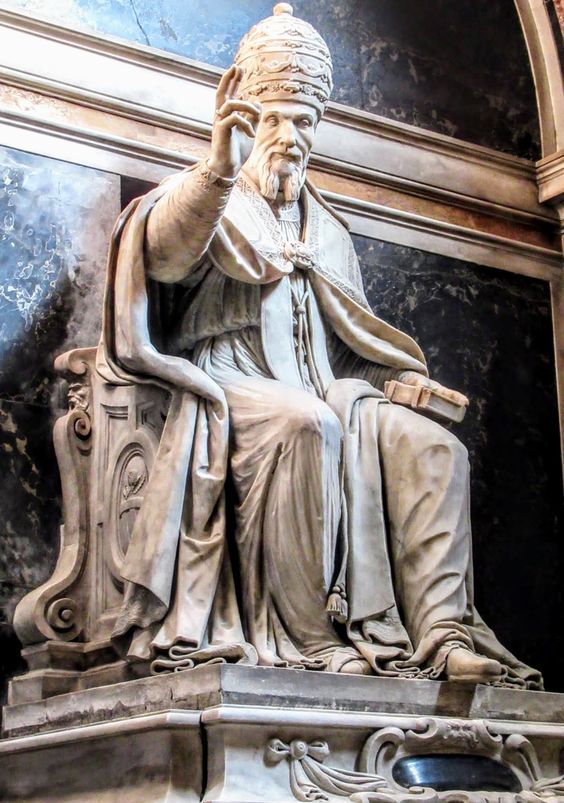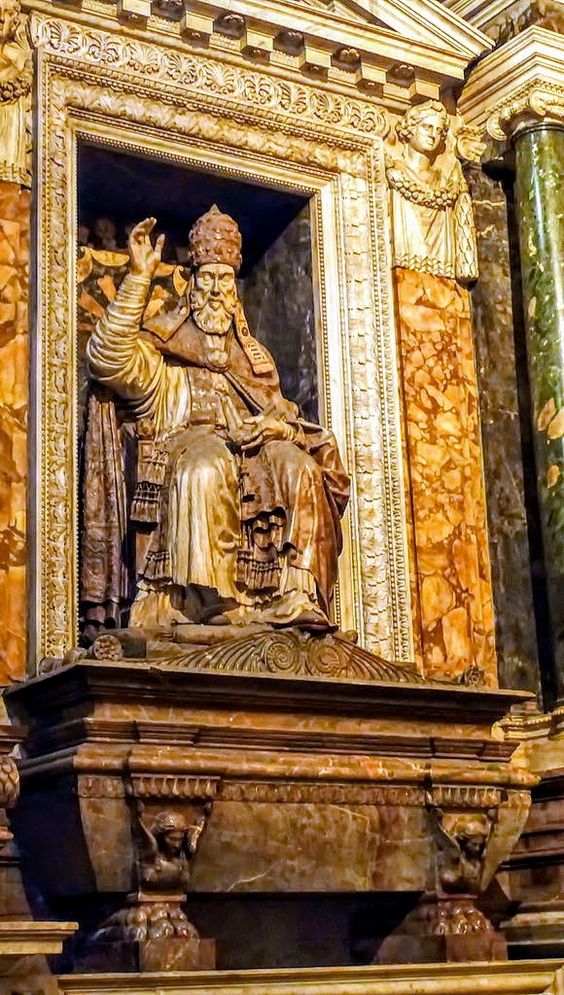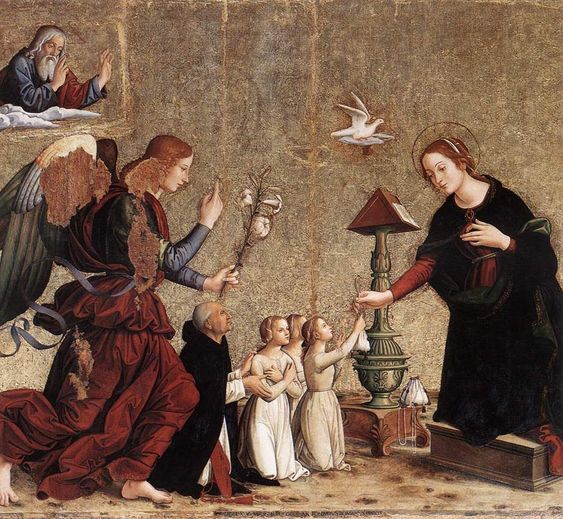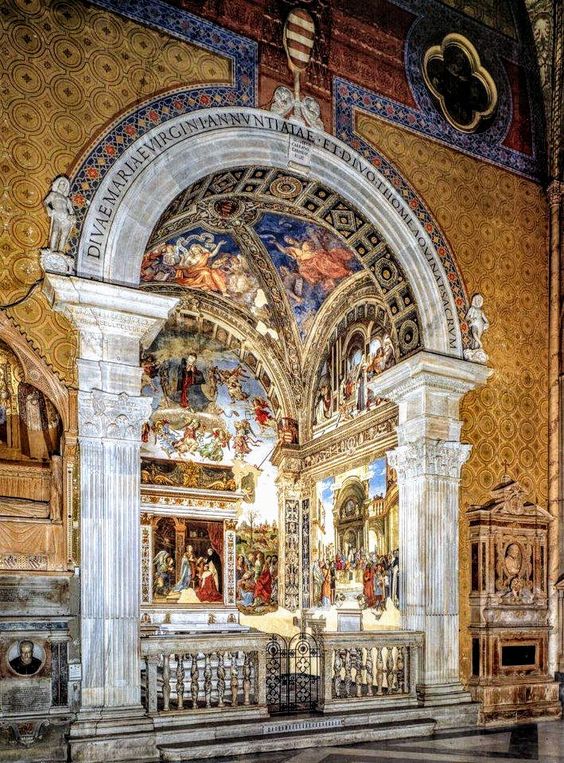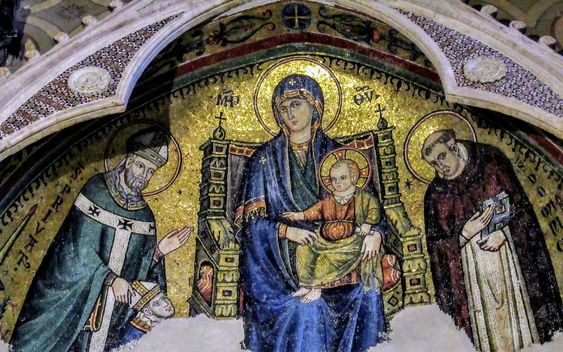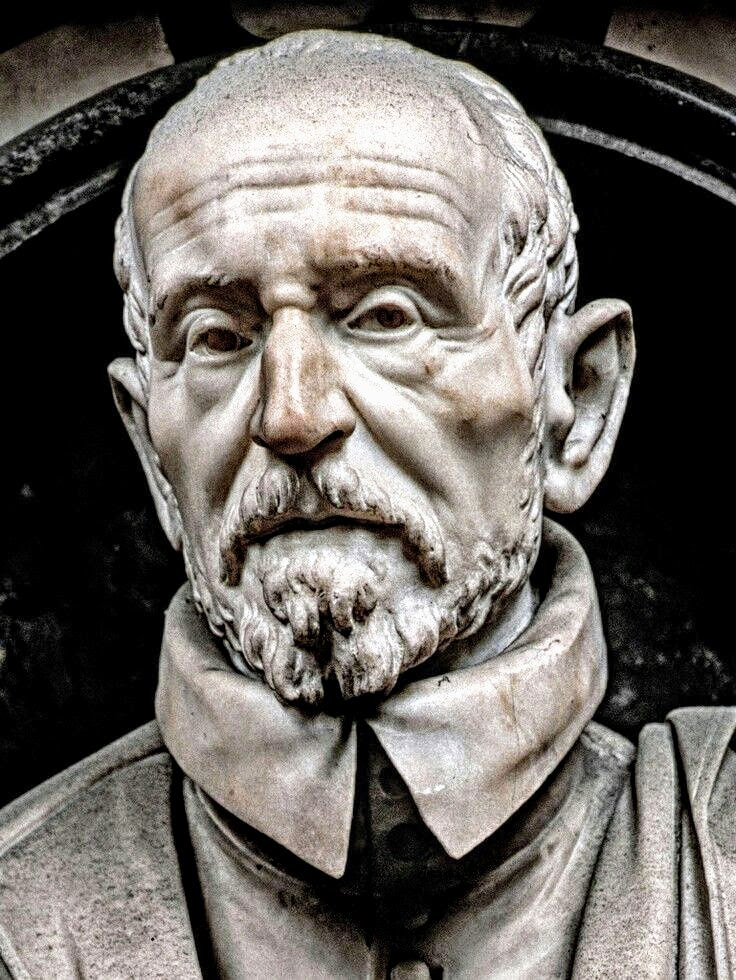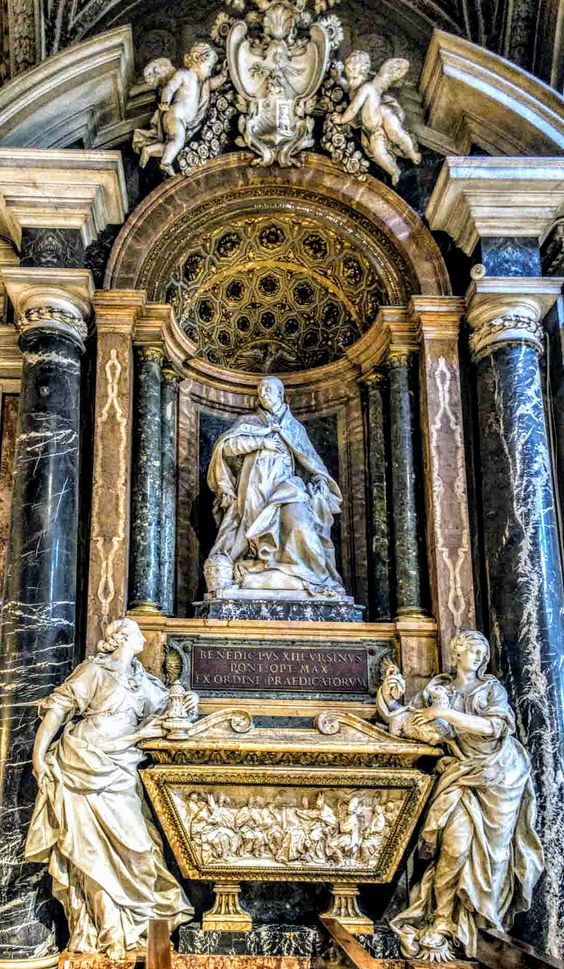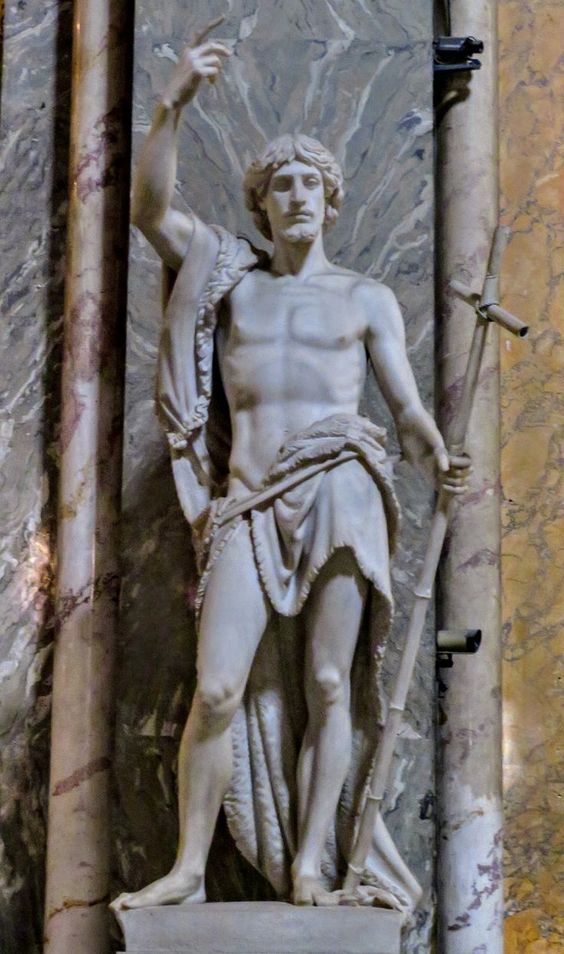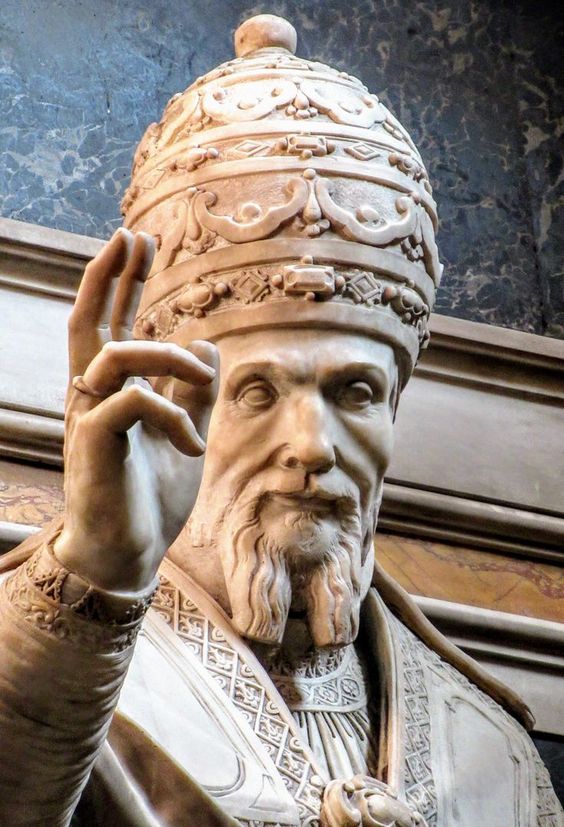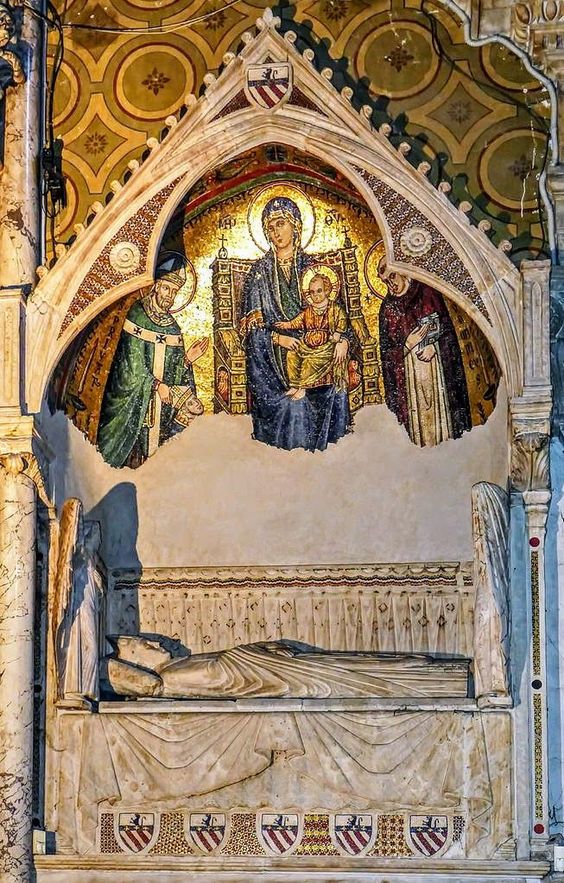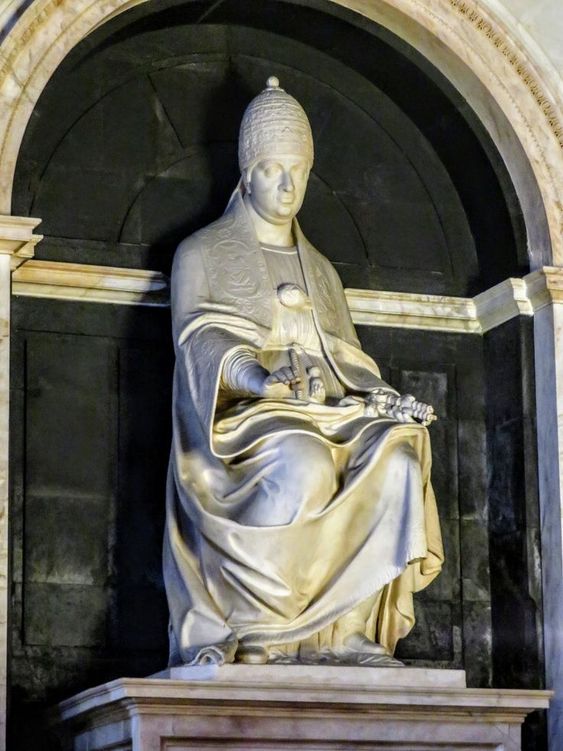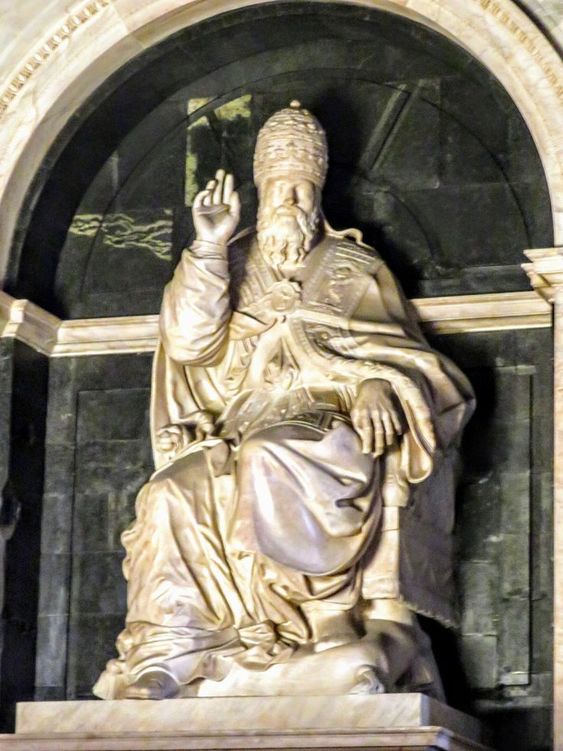- Home
- Walking Tours
- Blog
-
St Peter's Basilica
- Altars
- Baldacchino
- Chair of St Peter
- Chapel of the Baptistery
- Chapel of the Bl. Sacrament
- Chapel of the Choir
- Chapel of the Pieta
- Crossing >
- Dome
-
Monuments
>
- Countess Matilda of Canossa
- Maria Clementina Sobieska
- Queen Christina of Sweden
- Pope Innocent VIII
- Pope Paul III
- Pope Gregory XIII
- Pope Gregory XIV
- Pope Leo XI
- Pope Urban VIII
- Pope Alexander VII
- Pope Clement X
- Pope Innocent XI
- Pope Alexander VIII
- Pope Innocent XII
- Pope Benedict XIV
- Pope Clement XIII
- Pope Pius VII
- Pope Leo XII
- Pope Pius VIII
- Pope Gregory XVI
- Pope Pius X
- Pope Benedict XV
- Pope Pius XI
- Pope Pius XII
- Pope John XXIII
- The Stuarts
- Nave
- Portico >
- Statue of St Peter
- Statues of Founder Saints
- Transept
- Tribune
- St Peter's Square
- Vatican Museums
- Sistine Chapel
-
Fountains
- Trevi Fountain
- Fontana della Barcaccia
- Fontana della Peschiera
- Fountain in Piazza Colonna
- Fountain in Piazza delle Cinque Scole
- Fountain in Piazza dell' Aracoeli
- Fountain in Piazza Nicosia
- Fountain in Piazza di S.M. in Trastevere
- Fountain of Moses
- Fountain of Neptune
- Fountains of Piazza Farnese
- Fountain of Ponte Sisto
- Fountain of the Acqua Paola
- Fountain of the Bees
- Fountain of the Cannonball
- Fountain of the Frogs
- Fountain of the Four Rivers
- Fountain of the Goddess Roma
- Fountain of the Lateran Obelisk
- Fountain of the Mask
- Fountain of the Moor
- Fountain of the Naiads
- Fountain of the Pantheon
- Fountains of Piazza del Popolo
- Fountain of the Porter
- Fountains of St Peter's Square
- Fountain of the Seahorses
- Fountain of the Triton
- Fountain of the Turtles
- Fountains of the Two Seas
- Four Fountains
- Rioni Fountains
- Street Fountains
- Venice Marries the Sea
- On This Day in Rome
-
Churches
- Chiesa del Gesù >
- Chiesa Nuova
- Lateran Baptistery
- San Bartolomeo all' Isola
- San Benedetto in Piscinula
- San Bernardo alle Terme
- San Carlo ai Catinari
- San Carlo al Corso
- San Carlo alle Quattro Fontane
- San Clemente >
- San Crisogono
- San Francesco a Ripa >
- San Giorgio in Velabro
- San Giovanni a Porta Latina
- San Giovanni dei Fiorentini
- San Giovanni in Laterano >
- San Girolamo della Carità >
- San Gregorio Magno
- San Lorenzo fuori le Mura
- San Lorenzo in Damaso
- San Lorenzo in Lucina
- San Luigi dei Francesi >
- San Marcello al Corso
- San Marco
- San Martino ai Monti
- San Nicola in Carcere
- San Pancrazio
- San Paolo fuori le Mura
- San Pietro in Montorio
- San Pietro in Vincoli
- San Saba
- San Salvatore in Lauro
- San Sebastiano fuori le Mura >
- San Silvestro in Capite
- San Vitale
- Sant' Agnese fuori le Mura
- Sant' Agnese in Agone
- Sant' Agostino
- Sant' Alessio
- Sant' Anastasia
- Sant' Andrea al Quirinale
- Sant' Andrea della Valle
- Sant' Andrea delle Fratte
- Sant' Antonio dei Portoghesi
- Sant' Apollinare
- Sant' Eustachio
- Sant' Ignazio di Loyola
- Sant' Ivo alla Sapienza
- Santa Caterina dei Funari
- Santa Cecilia in Trastevere
- Santa Costanza
- Santa Croce in Gerusalemme >
- Santa Francesca Romana
- Santa Maria ad Martyres
- Santa Maria degli Angeli
- Santa Maria dei Miracoli
- Santa Maria del Popolo >
- Santa Maria del Priorato
- Santa Maria della Pace >
- Santa Maria della Vittoria >
- Santa Maria dell' Anima
- Santa Maria dell' Orazione e Morte
- Santa Maria dell' Orto
- Santa Maria di Loreto
- Santa Maria in Aracoeli >
- Santa Maria in Campitelli
- Santa Maria in Cosmedin
- Santa Maria in Domnica
- Santa Maria in Montesanto
- Santa Maria in Trastevere >
- Santa Maria in Via
- Santa Maria in Via Lata
- Santa Maria Maddalena
- Santa Maria Maggiore >
- Santa Maria sopra Minerva >
- Santa Prassede
- Santa Pudenziana
- Santa Sabina >
- Santa Susanna
- Santi Apostoli
- Santi Cosma e Damiano
- Santi Domenico e Sisto
- Santi Giovanni e Paolo
- Santi Luca e Martina
- Santi Nereo e Achilleo
- Santi Quattro Coronati
- Santi Vincenzo e Anastasio
- Santissima Trinità degli Spagnoli
- Santissima Trinità dei Pellegrini
- Santissima Trinità di Monti
- Santissimo Nome di Maria
- Santo Stefano Rotondo
- Palatine
- Forum
-
Ancient Monuments
- Aqueducts
- Ara Pacis
- Arch of Constantine
- Arch of the Money-Changers
- Arch of Janus
- Aurelian Walls
- Baths of Caracalla
- Baths of Diocletian
- Castel Sant' Angelo
- Catacombs of Domitilla
- Circus Maxentius
- Circus Maximus
- Colosseum
- Column of Marcus Aurelius
- Column of Trajan
- Forum of Augustus
- Forum of Trajan
- Mausoleum of Augustus
- Nymphaeum
- Pantheon
- Ponte Fabricio
- Ponte Milvio
- Ponte Rotto
- Ponte Sant' Angelo
- Porta Maggiore
- Porta San Paolo
- Porta San Sebastiano
- Portico of Octavia
- Pyramid of Cestius
- Temple of Hadrian
- Temple of Hercules
- Temple of Portunus
- Theatre of Balbus
- Theatre of Marcellus
- Theatre of Pompey
- Tomb of Caecilia Metella
- Via Appia
-
Obelisks
- 'Minerveo' Obelisk
- 'Flaminio' Obelisk
- 'Matteiano' Obelisk
- 'Lateran' Obelisk
- 'Dogali' Obelisk
- 'Macuteo' Obelisk
- 'Solare' Obelisk
- 'Vatican' Obelisk
- 'Agonalis' Obelisk
- 'Sallustiano' Obelisk
- 'Quirinale' Obelisk
- 'Esquiline' Obelisk
- 'Pinciano' Obelisk
- 'Mediceo' Obelisk
- 'Torlonia' Obelisks
- 'Mussolini' Obelisk
- 'Marconi' Obelisk
-
Mosaics
- Gallery
- Palazzi
- Galleries & Museums
- Piazzas
-
Miscellaneous
- A Calendar of Saints
- A Literary Tour
- Antico Caffè Greco
- Art of the Cosmati
- Babington's Tea Rooms
- Barberini Bees
- Gian Lorenzo Bernini
- Borromini & the Baroque
- Catacombs
- Column of the Immaculate Conception
- Domes
- Equestrian Statues
- EUR
- Fasces
- Flood Plaques
- Funerary Monuments
- House of the Owls
- Jewish Ghetto
- Jubilee Years
- Knights of Malta
- Mithraism
- Monumental Complex of S. Spirito in Sassia
- Ponte Sisto
- Porta Pia
- 'Protestant' Cemetery
- Quartiere Coppedè
- Scala Santa
- Spanish Steps
- 'Talking' Statues
- Tiber Island
- Villa Borghese
- Vittoriano
- Rioni
- On This Day in Italy
-
Pictures from Italy
-
Florence
>
- A Literary Tour
- Anna Maria Luisa: Last of the Medici
- Casa-Galleria Vichi
- Column of Justice
- Column of St Zenobius
- Cosimo I de' Medici
- Cosimo II de' Medici
- Costanza Bonarelli
- David With Fig Leaf
- Elizabeth Barrett Browning
- Equestrian Statue of Cosimo I de' Medici
- Equestrian Statue of Ferdinando I de' Medici
- Festina Lente
- Floods
- Fontana del Bacchino
- Fontana dei Puttini
- Fountain of Neptune
- Fountains of the Marine Monsters
- Gian Gastone de' Medici
- Girolamo Savonarola
- Images of the Annunciation
- Little Devil
- Monument to Cellini
- Palazzo Bartolini-Salimbeni
- Palazzo Bianca Cappello
- Palazzo Fenzi
- Palazzo Viviani
- Perseus and Medusa
- Piazza Santa Maria Novella
- Pope Leo XI
- Porta della Mandorla
- Rape of the Sabine Woman
- Santa Maria Novella
- Canons' Palace
- Statue of Dante
- Theft of the Century
- Torre del Arnolfo
- Twelve Good Men
- Villa Gamberaia
- Wheel of the Innocents
- 'Wine Windows'
- Lazio >
- Tuscany >
-
Venice
>
- Ab Urbe Condita
- Acqua Alta
- Bartolomeo Colleoni
- Barque of Dante
- Burano
- Caffè Florian
- Daniele Manin
- Flagpoles
- Giustina Rossi
- Gondolas
- Harry's Bar
- Henry James
- House of Three Eyes
- King Victor Emmanuel II
- Map of Venice
- Martinmas
- Master of the House
- Palazzo Contarini Fasan
- Ponte Borgoloco
- Ponte Chiodo
- Punta del Dogana
- Scacciadiavoli
- Shrine of St Lucia
- Sior Antonio Rioba
- The 'Book Shitter'
- The Lion's Mouth
- Tommaso Rangone
- Torcello
- Venus
- 'Viennese Oranges'
- Wellheads
- Winged Lions
-
Florence
>
- Popes: 1417-Present
- Cloisters
Santa Maria sopra Minerva
Santa Maria sopra Minerva is Rome’s only medieval Gothic church. Work began in 1280 and continued for almost a century until 1370. The church was transformed during both the Renaissance and Baroque periods and ‘restored’ in the middle of the 19th century.
The church was thought to have been built on top of an ancient Roman temple dedicated to the goddess Minerva, hence its name. In truth, the church and adjoining convent occupy the site of three ancient temples, one Roman and the other two Egyptian (the Isèum dedicated to the goddess Isis and the Serapèum dedicated to the god Serapide).
For millennia Rome was prone to heavy flooding and part of the façade of Santa Maria sopra Minerva is decorated with plaques, which record some of the heights the flood waters reached.
The church was thought to have been built on top of an ancient Roman temple dedicated to the goddess Minerva, hence its name. In truth, the church and adjoining convent occupy the site of three ancient temples, one Roman and the other two Egyptian (the Isèum dedicated to the goddess Isis and the Serapèum dedicated to the god Serapide).
For millennia Rome was prone to heavy flooding and part of the façade of Santa Maria sopra Minerva is decorated with plaques, which record some of the heights the flood waters reached.
Santa Maria sopra Minerva, which belongs to the Dominican Order, is made up of a nave, two aisles, two transepts and a choir. The aisles are lined with private chapels. A chapel of particular interest is the fifth off the right aisle, the Cappella dell' Annunziata.
The sixth chapel is the Cappella Aldobrandini. When, in 1592, Cardinal Ippolito Aldobrandini became Pope Clement VIII (r. 1592-1605) he had the family chapel enlarged and redecorated. The altarpiece is by Federico Fiori, also known as Federico Barocci (c.1535-1612) or Il Baroccio, and depicts the Institution of the Holy Eucharist (1594). The painting is flanked by statues of St Peter and St Paul, the work of Camillo Mariani. The tombs of the pope’s mother and father line the side walls, while a rather modest statue of the pope, himself, stands in a niche to the back of the left wall.
The right transept is home to the Cappella Carafa, which is home to some of the most beautiful Renaissance frescoes to be found in Rome.
The transept also houses the late-13th century Gothic tomb of Bishop Guillaume Durand (died 1296), the signed work of Giovanni di Cosma (died c. 1305). The partially destroyed mosaic depicts the Virgin and Child flanked by San Domenico and San Privato. All that remains of the poor bishop is his head.
The sixth chapel is the Cappella Aldobrandini. When, in 1592, Cardinal Ippolito Aldobrandini became Pope Clement VIII (r. 1592-1605) he had the family chapel enlarged and redecorated. The altarpiece is by Federico Fiori, also known as Federico Barocci (c.1535-1612) or Il Baroccio, and depicts the Institution of the Holy Eucharist (1594). The painting is flanked by statues of St Peter and St Paul, the work of Camillo Mariani. The tombs of the pope’s mother and father line the side walls, while a rather modest statue of the pope, himself, stands in a niche to the back of the left wall.
The right transept is home to the Cappella Carafa, which is home to some of the most beautiful Renaissance frescoes to be found in Rome.
The transept also houses the late-13th century Gothic tomb of Bishop Guillaume Durand (died 1296), the signed work of Giovanni di Cosma (died c. 1305). The partially destroyed mosaic depicts the Virgin and Child flanked by San Domenico and San Privato. All that remains of the poor bishop is his head.
Lying before the high altar is the tomb of St Catherine of Siena (1347-80), which is ascribed to the sculptor Isaia da Pisa (active 1447-64). Catherine Benincasa was canonised in 1461 by Pope Pius II (r. 1458-64), himself a citizen of the Republic of Siena. However, her effigy was carved before this event, which is why the edge of her pillow is inscribed Beata Katerina, a reference to her earlier beatification.
The choir is home to the funerary monuments of two Medici Popes, Leo X (r. 1513-21) and Pope Clement VII (r. 1523-34). The statue of Pope Leo X (left) is by Raffaello da Montelupo (1504-66), and that of Pope Clement VII is by Nanni di Baccio Bigio (1512-68). The statues of prophets and the bas-reliefs are by Baccio Bandinelli.
There are only three churches in Rome which can boast a sculpture by Michelangelo and Santa Maria sopra Minerva is one of them. Michelangelo’s statue of the Risen Christ (1519-21) stands to the left of the high altar. Christ, who is portrayed standing entirely naked, holds the Cross and the instruments of his Passion. The gilded ‘loin cloth’ was a later addition.
It should be added that this sculpture was Michelangelo’s second version and one with which he remained dissatisfied. He was assisted in its completion by a young assistant, Pietro Urbano. As the pupil’s work fell far short from the high standards demanded by the master, he was soon dismissed. Michelangelo had discarded the first version on discovering a black vein in the marble, which marred the face. The statue now stands in the sacristy of the church of San Vincenzo in the small town of Bassano Romano, which lies about forty miles to the north of Rome.
The choir is home to the funerary monuments of two Medici Popes, Leo X (r. 1513-21) and Pope Clement VII (r. 1523-34). The statue of Pope Leo X (left) is by Raffaello da Montelupo (1504-66), and that of Pope Clement VII is by Nanni di Baccio Bigio (1512-68). The statues of prophets and the bas-reliefs are by Baccio Bandinelli.
There are only three churches in Rome which can boast a sculpture by Michelangelo and Santa Maria sopra Minerva is one of them. Michelangelo’s statue of the Risen Christ (1519-21) stands to the left of the high altar. Christ, who is portrayed standing entirely naked, holds the Cross and the instruments of his Passion. The gilded ‘loin cloth’ was a later addition.
It should be added that this sculpture was Michelangelo’s second version and one with which he remained dissatisfied. He was assisted in its completion by a young assistant, Pietro Urbano. As the pupil’s work fell far short from the high standards demanded by the master, he was soon dismissed. Michelangelo had discarded the first version on discovering a black vein in the marble, which marred the face. The statue now stands in the sacristy of the church of San Vincenzo in the small town of Bassano Romano, which lies about forty miles to the north of Rome.
A short distance from Michelangelo’s statue lies the tomb of the Florentine painter, Fra Angelico, who died in Rome on February 18th, 1455. Fra Angelico was also a Dominican priest, which is why Santa Maria sopra Minerva became his final resting place.
In the chapel behind the tombstone, the Cappella Frangipane, there is an example of the work of Benozzo Gozzoli, Fra Angelico’s most famous pupil. It is a painting on silk of the Virgin and Child and would once have served as a processional banner. The chapel is also home to a Renaissance funerary monument, which uses a recycled ancient sarcophagus in its design. The sarcophagus is decorated with a beautiful image of Hercules fighting the Nemean lion and on top of it lies the effigy of Giovanni Arberini.
The left transept is home to the Chapel of St Dominic, which houses the funerary monument of Pope Benedict XIII (r. 1724-30), who was himself a Dominican. The chapel was designed by Filippo Raguzzini (1690-1771) and the monument by Carlo Marchionni (1702-86). The statue of the pope is by Pietro Bracci (1700-73). The two allegorical figures, who are leaning on the sarcophagus, represent Religion and Purity, the work, respectively, of Bartolomeo Pincellotti (1707-40) and Pietro Bracci. Marchionni executed the bas-relief.
The great Baroque sculptor Gian Lorenzo Bernini (1598-1680) was to the 17th century what Michelangelo had been to the 16th and Santa Maria sopra Minerva is fortunate enough to boast two documented works by the master. His polychrome monument to Suor Maria Raggi adorns the fifth pillar on the left side of the nave. It was created after 1647, the year Lorenzo Raggi, one of her descendants, became a cardinal. His name, and that of Ottaviano and Tommaso Raggi, are noted in the Latin inscription at the bottom of the memorial. Maria Raggi (1552-1600) was a nun, who lived in a palazzo near the church. Extremely pious, she spent much of her day in prayer and reportedly performed many miracles.
Bernini’s animated bust of Giovanni Vigevano is the highlight of the funerary monument, which stands between the third and fourth chapels off the left aisle. The whole monument was once thought to be his work, but most scholars now think that only the bust can be securely attributed to him. Bernini was only a teenager when he carved it.
When you leave the church look out for an image of a dog seated on a book with a torch in its mouth, which can be seen over the side doors. The Dominicans were often known as the Domini Canes (Dogs of the Lord); the torch represents the flame of Christian truth, which the Dominican Order worked to promote in its battle against heresy.
In the chapel behind the tombstone, the Cappella Frangipane, there is an example of the work of Benozzo Gozzoli, Fra Angelico’s most famous pupil. It is a painting on silk of the Virgin and Child and would once have served as a processional banner. The chapel is also home to a Renaissance funerary monument, which uses a recycled ancient sarcophagus in its design. The sarcophagus is decorated with a beautiful image of Hercules fighting the Nemean lion and on top of it lies the effigy of Giovanni Arberini.
The left transept is home to the Chapel of St Dominic, which houses the funerary monument of Pope Benedict XIII (r. 1724-30), who was himself a Dominican. The chapel was designed by Filippo Raguzzini (1690-1771) and the monument by Carlo Marchionni (1702-86). The statue of the pope is by Pietro Bracci (1700-73). The two allegorical figures, who are leaning on the sarcophagus, represent Religion and Purity, the work, respectively, of Bartolomeo Pincellotti (1707-40) and Pietro Bracci. Marchionni executed the bas-relief.
The great Baroque sculptor Gian Lorenzo Bernini (1598-1680) was to the 17th century what Michelangelo had been to the 16th and Santa Maria sopra Minerva is fortunate enough to boast two documented works by the master. His polychrome monument to Suor Maria Raggi adorns the fifth pillar on the left side of the nave. It was created after 1647, the year Lorenzo Raggi, one of her descendants, became a cardinal. His name, and that of Ottaviano and Tommaso Raggi, are noted in the Latin inscription at the bottom of the memorial. Maria Raggi (1552-1600) was a nun, who lived in a palazzo near the church. Extremely pious, she spent much of her day in prayer and reportedly performed many miracles.
Bernini’s animated bust of Giovanni Vigevano is the highlight of the funerary monument, which stands between the third and fourth chapels off the left aisle. The whole monument was once thought to be his work, but most scholars now think that only the bust can be securely attributed to him. Bernini was only a teenager when he carved it.
When you leave the church look out for an image of a dog seated on a book with a torch in its mouth, which can be seen over the side doors. The Dominicans were often known as the Domini Canes (Dogs of the Lord); the torch represents the flame of Christian truth, which the Dominican Order worked to promote in its battle against heresy.
Gallery
- Home
- Walking Tours
- Blog
-
St Peter's Basilica
- Altars
- Baldacchino
- Chair of St Peter
- Chapel of the Baptistery
- Chapel of the Bl. Sacrament
- Chapel of the Choir
- Chapel of the Pieta
- Crossing >
- Dome
-
Monuments
>
- Countess Matilda of Canossa
- Maria Clementina Sobieska
- Queen Christina of Sweden
- Pope Innocent VIII
- Pope Paul III
- Pope Gregory XIII
- Pope Gregory XIV
- Pope Leo XI
- Pope Urban VIII
- Pope Alexander VII
- Pope Clement X
- Pope Innocent XI
- Pope Alexander VIII
- Pope Innocent XII
- Pope Benedict XIV
- Pope Clement XIII
- Pope Pius VII
- Pope Leo XII
- Pope Pius VIII
- Pope Gregory XVI
- Pope Pius X
- Pope Benedict XV
- Pope Pius XI
- Pope Pius XII
- Pope John XXIII
- The Stuarts
- Nave
- Portico >
- Statue of St Peter
- Statues of Founder Saints
- Transept
- Tribune
- St Peter's Square
- Vatican Museums
- Sistine Chapel
-
Fountains
- Trevi Fountain
- Fontana della Barcaccia
- Fontana della Peschiera
- Fountain in Piazza Colonna
- Fountain in Piazza delle Cinque Scole
- Fountain in Piazza dell' Aracoeli
- Fountain in Piazza Nicosia
- Fountain in Piazza di S.M. in Trastevere
- Fountain of Moses
- Fountain of Neptune
- Fountains of Piazza Farnese
- Fountain of Ponte Sisto
- Fountain of the Acqua Paola
- Fountain of the Bees
- Fountain of the Cannonball
- Fountain of the Frogs
- Fountain of the Four Rivers
- Fountain of the Goddess Roma
- Fountain of the Lateran Obelisk
- Fountain of the Mask
- Fountain of the Moor
- Fountain of the Naiads
- Fountain of the Pantheon
- Fountains of Piazza del Popolo
- Fountain of the Porter
- Fountains of St Peter's Square
- Fountain of the Seahorses
- Fountain of the Triton
- Fountain of the Turtles
- Fountains of the Two Seas
- Four Fountains
- Rioni Fountains
- Street Fountains
- Venice Marries the Sea
- On This Day in Rome
-
Churches
- Chiesa del Gesù >
- Chiesa Nuova
- Lateran Baptistery
- San Bartolomeo all' Isola
- San Benedetto in Piscinula
- San Bernardo alle Terme
- San Carlo ai Catinari
- San Carlo al Corso
- San Carlo alle Quattro Fontane
- San Clemente >
- San Crisogono
- San Francesco a Ripa >
- San Giorgio in Velabro
- San Giovanni a Porta Latina
- San Giovanni dei Fiorentini
- San Giovanni in Laterano >
- San Girolamo della Carità >
- San Gregorio Magno
- San Lorenzo fuori le Mura
- San Lorenzo in Damaso
- San Lorenzo in Lucina
- San Luigi dei Francesi >
- San Marcello al Corso
- San Marco
- San Martino ai Monti
- San Nicola in Carcere
- San Pancrazio
- San Paolo fuori le Mura
- San Pietro in Montorio
- San Pietro in Vincoli
- San Saba
- San Salvatore in Lauro
- San Sebastiano fuori le Mura >
- San Silvestro in Capite
- San Vitale
- Sant' Agnese fuori le Mura
- Sant' Agnese in Agone
- Sant' Agostino
- Sant' Alessio
- Sant' Anastasia
- Sant' Andrea al Quirinale
- Sant' Andrea della Valle
- Sant' Andrea delle Fratte
- Sant' Antonio dei Portoghesi
- Sant' Apollinare
- Sant' Eustachio
- Sant' Ignazio di Loyola
- Sant' Ivo alla Sapienza
- Santa Caterina dei Funari
- Santa Cecilia in Trastevere
- Santa Costanza
- Santa Croce in Gerusalemme >
- Santa Francesca Romana
- Santa Maria ad Martyres
- Santa Maria degli Angeli
- Santa Maria dei Miracoli
- Santa Maria del Popolo >
- Santa Maria del Priorato
- Santa Maria della Pace >
- Santa Maria della Vittoria >
- Santa Maria dell' Anima
- Santa Maria dell' Orazione e Morte
- Santa Maria dell' Orto
- Santa Maria di Loreto
- Santa Maria in Aracoeli >
- Santa Maria in Campitelli
- Santa Maria in Cosmedin
- Santa Maria in Domnica
- Santa Maria in Montesanto
- Santa Maria in Trastevere >
- Santa Maria in Via
- Santa Maria in Via Lata
- Santa Maria Maddalena
- Santa Maria Maggiore >
- Santa Maria sopra Minerva >
- Santa Prassede
- Santa Pudenziana
- Santa Sabina >
- Santa Susanna
- Santi Apostoli
- Santi Cosma e Damiano
- Santi Domenico e Sisto
- Santi Giovanni e Paolo
- Santi Luca e Martina
- Santi Nereo e Achilleo
- Santi Quattro Coronati
- Santi Vincenzo e Anastasio
- Santissima Trinità degli Spagnoli
- Santissima Trinità dei Pellegrini
- Santissima Trinità di Monti
- Santissimo Nome di Maria
- Santo Stefano Rotondo
- Palatine
- Forum
-
Ancient Monuments
- Aqueducts
- Ara Pacis
- Arch of Constantine
- Arch of the Money-Changers
- Arch of Janus
- Aurelian Walls
- Baths of Caracalla
- Baths of Diocletian
- Castel Sant' Angelo
- Catacombs of Domitilla
- Circus Maxentius
- Circus Maximus
- Colosseum
- Column of Marcus Aurelius
- Column of Trajan
- Forum of Augustus
- Forum of Trajan
- Mausoleum of Augustus
- Nymphaeum
- Pantheon
- Ponte Fabricio
- Ponte Milvio
- Ponte Rotto
- Ponte Sant' Angelo
- Porta Maggiore
- Porta San Paolo
- Porta San Sebastiano
- Portico of Octavia
- Pyramid of Cestius
- Temple of Hadrian
- Temple of Hercules
- Temple of Portunus
- Theatre of Balbus
- Theatre of Marcellus
- Theatre of Pompey
- Tomb of Caecilia Metella
- Via Appia
-
Obelisks
- 'Minerveo' Obelisk
- 'Flaminio' Obelisk
- 'Matteiano' Obelisk
- 'Lateran' Obelisk
- 'Dogali' Obelisk
- 'Macuteo' Obelisk
- 'Solare' Obelisk
- 'Vatican' Obelisk
- 'Agonalis' Obelisk
- 'Sallustiano' Obelisk
- 'Quirinale' Obelisk
- 'Esquiline' Obelisk
- 'Pinciano' Obelisk
- 'Mediceo' Obelisk
- 'Torlonia' Obelisks
- 'Mussolini' Obelisk
- 'Marconi' Obelisk
-
Mosaics
- Gallery
- Palazzi
- Galleries & Museums
- Piazzas
-
Miscellaneous
- A Calendar of Saints
- A Literary Tour
- Antico Caffè Greco
- Art of the Cosmati
- Babington's Tea Rooms
- Barberini Bees
- Gian Lorenzo Bernini
- Borromini & the Baroque
- Catacombs
- Column of the Immaculate Conception
- Domes
- Equestrian Statues
- EUR
- Fasces
- Flood Plaques
- Funerary Monuments
- House of the Owls
- Jewish Ghetto
- Jubilee Years
- Knights of Malta
- Mithraism
- Monumental Complex of S. Spirito in Sassia
- Ponte Sisto
- Porta Pia
- 'Protestant' Cemetery
- Quartiere Coppedè
- Scala Santa
- Spanish Steps
- 'Talking' Statues
- Tiber Island
- Villa Borghese
- Vittoriano
- Rioni
- On This Day in Italy
-
Pictures from Italy
-
Florence
>
- A Literary Tour
- Anna Maria Luisa: Last of the Medici
- Casa-Galleria Vichi
- Column of Justice
- Column of St Zenobius
- Cosimo I de' Medici
- Cosimo II de' Medici
- Costanza Bonarelli
- David With Fig Leaf
- Elizabeth Barrett Browning
- Equestrian Statue of Cosimo I de' Medici
- Equestrian Statue of Ferdinando I de' Medici
- Festina Lente
- Floods
- Fontana del Bacchino
- Fontana dei Puttini
- Fountain of Neptune
- Fountains of the Marine Monsters
- Gian Gastone de' Medici
- Girolamo Savonarola
- Images of the Annunciation
- Little Devil
- Monument to Cellini
- Palazzo Bartolini-Salimbeni
- Palazzo Bianca Cappello
- Palazzo Fenzi
- Palazzo Viviani
- Perseus and Medusa
- Piazza Santa Maria Novella
- Pope Leo XI
- Porta della Mandorla
- Rape of the Sabine Woman
- Santa Maria Novella
- Canons' Palace
- Statue of Dante
- Theft of the Century
- Torre del Arnolfo
- Twelve Good Men
- Villa Gamberaia
- Wheel of the Innocents
- 'Wine Windows'
- Lazio >
- Tuscany >
-
Venice
>
- Ab Urbe Condita
- Acqua Alta
- Bartolomeo Colleoni
- Barque of Dante
- Burano
- Caffè Florian
- Daniele Manin
- Flagpoles
- Giustina Rossi
- Gondolas
- Harry's Bar
- Henry James
- House of Three Eyes
- King Victor Emmanuel II
- Map of Venice
- Martinmas
- Master of the House
- Palazzo Contarini Fasan
- Ponte Borgoloco
- Ponte Chiodo
- Punta del Dogana
- Scacciadiavoli
- Shrine of St Lucia
- Sior Antonio Rioba
- The 'Book Shitter'
- The Lion's Mouth
- Tommaso Rangone
- Torcello
- Venus
- 'Viennese Oranges'
- Wellheads
- Winged Lions
-
Florence
>
- Popes: 1417-Present
- Cloisters
